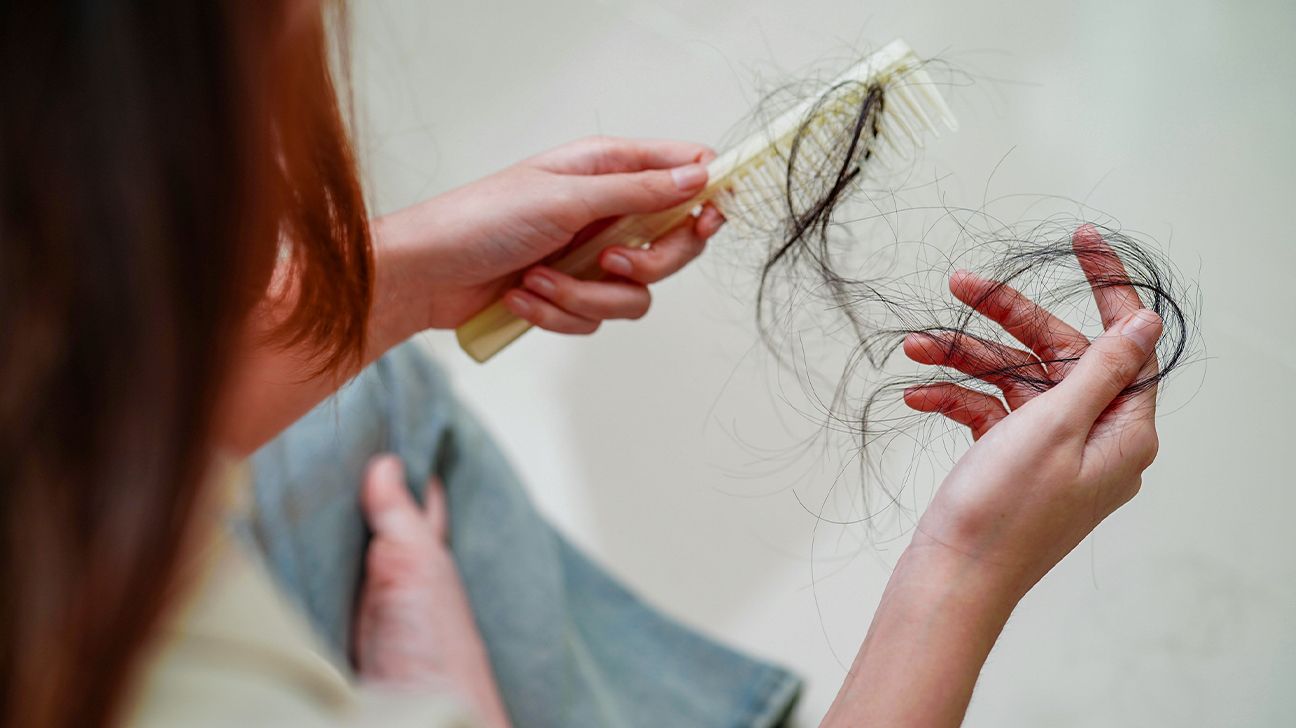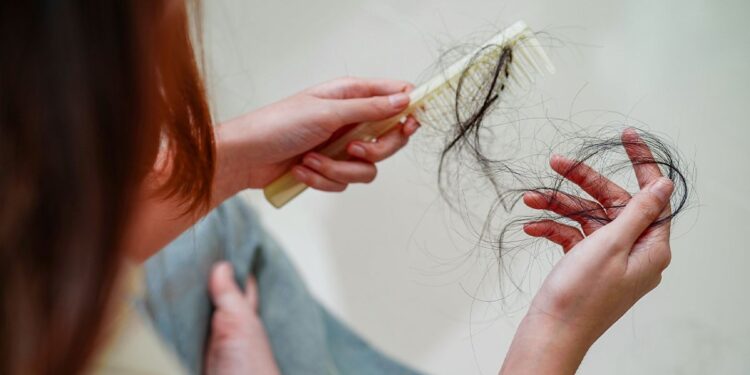
- Women may experience hair loss for many reasons, including genetics, stress, and aging.
- Certain home remedies may provide modest benefits for hair health, but many lack scientific evidence.
- A dermatologist can recommend the most effective medications and treatments for female hair loss.
Noticing more hair on your pillow, in the shower, or on your brush can be a stressful experience for anyone.
While losing around 50 to 100 strands of hair each day is completely natural, when hair loss is more than normal, it can spark anxiety about whether there is a health issue happening beneath the surface.
From kitchen remedies and essential oils to massages and nutritional supplements, countless solutions promise thicker, healthier hair for women, yet it’s hard to know what really works.
At the same time, medical treatments exist for cases where hair loss is more than cosmetic, but figuring out when and how to seek professional help isn’t always straightforward.
If you’ve ever wondered what causes female hair loss, whether home remedies actually make a difference, or when it’s time to call your doctor, our experts will help you separate myth from reality.
What are some common causes of female hair loss?
Susan Massick, MD, a board certified dermatologist at The Ohio State University Wexner Medical Center, told Healthline there are several common causes of hair loss in women.
Androgenic alopecia, also known as female pattern hair loss, is a hereditary condition where the hair follicles shrink and stop growing hair.
In women, this type of hair loss occurs “mainly on the vertex of the scalp, although some women do note thinning along the frontal hairline, particularly near the temporal scalp,” she said.
Massick explained that there are also certain medical conditions that can cause hair loss, including:
- Thyroid disease, including both hyperthyroidism (overactive thyroid) and hypothyroidism (underactive thyroid)
- Nutrient deficiencies, such as low iron, protein, zinc, or biotin
- Autoimmune conditions, like alopecia areata, lupus, and lichen planopilaris, in which the immune system begins to attack hair follicles, causing hair to fall out
- Polycystic ovarian syndrome (PCOS), a condition in which women develop small cysts on their ovaries as well as hormonal imbalances
Anything that stresses the body can lead to a type of hair loss called “telogen effluvium,” in which there is rapid, all-over shedding of hair, she added.
High fevers, severe infections, surgeries, childbirth, rapid weight loss, and psychosocial stressors from work or home life are all potential causes of telogen effluvium.
Certain medications and chemotherapy can also be culprits in hair loss, Massick said.
She further pointed out that the normal hormonal shifts that women experience throughout their lifespan, such as pregnancy, childbirth, and menopause, may cause hair shedding.
Massick additionally noted the impacts of hairstyling techniques, explaining that traction alopecia can occur, especially along the front hairline, when women wear tight braids, use heat styling methods like flat-ironing, or use chemical treatments like perms, dyes, and relaxers.
How effective are home remedies for hair loss?
Marie Jhin, MD, a board certified dermatologist and the Chief Medical Officer atMusely, said that natural remedies can help support hair and scalp health, but their results are usually modest.
“Coconut oil, for example, can strengthen strands and reduce breakage, but it is unlikely to spark new growth,” she said.
“Rosemary and peppermint oils may boost circulation to the scalp, but studies are limited.”
Jhin said that red ginseng and onion juice have shown some benefit in small studies, but are not considered to be reliable treatments on their own.
“Scalp massage can temporarily increase blood flow, which may feel soothing but will not reverse significant thinning,” she added.
Jhin noted that while these natural remedies may complement proven medical therapies, they cannot replace a visit to a dermatologist.
Massick added that it’s important to be gentle in your haircare routine and eat a well-balanced diet. She suggested taking care of any health or lifestyle factors that might be contributing to your hair loss.
“[Have] your thyroid, hemoglobin (i.e., blood counts), and iron/ferritin levels checked; manage stress; no smoking; get plenty of rest,” she advised.
What hair loss treatments are available?
Massick said the first thing to know about treating hair loss is it’s “a marathon, not a sprint.” She suggests being patient and being realistic about the fact that it may take six months or more to see results.
She additionally discussed the following treatment options available through your dermatologist.
Medications
Minoxidil (Rogaine)
When it comes to medications, she said minoxidil, in both topical and oral forms, may be used to combat thinning hair.
“Although the exact mechanism of action is unknown, it is thought that improved blood flow to the hair follicles prevents hair shedding and perhaps enhances hair regrowth,” she explained.
According to Massick, minoxidil has some pluses: It has been widely studied and clinically proven to slow hair loss. It is easy to use and generally considered safe. It can also be obtained over the counter or by prescription.
However, it does have some downsides. It must be used consistently; you will lose any gains if you stop using it. Additionally, it can take a minimum of six months for women to see improvement. Also, it is not safe for those who are or may be pregnant or who are nursing.
Finasteride (Propecia)
This drug is often used to treat enlarged prostates in males as well as male pattern hair loss.
While the Food and Drug Administration (FDA) has not approved it for use in women, Massick said some doctors may consider its use, in both topical and oral forms, for female-pattern hair loss.
However, finasteride is only considered to be appropriate for those who are postmenopausal or otherwise unable to bear children.
Finasteride inhibits type II 5-alpha-reductase, the enzyme that converts testosterone into dihydrotestosterone (DHT).
“By blocking the conversion of testosterone to DHT, finasteride prevents the miniaturization of the hair follicles, arresting the hair loss,” explained Massick.
Although this medication is convenient to use — it can be taken as a once-a-day pill—and it’s clinically proven to stop hair loss and even sometimes induce hair regrowth, it also works only as long as you are using it and may not work well for everyone.
Its potential to cause birth defects in male babies also limits its use in women of childbearing age.
Dutasteride (Avodart)
According to Massick, oral dutasteride inhibits both type I and type II 5-alpha-reductase enzymes.
Because of this dual inhibition, “[It] appears to hold a slight advantage over finasteride in limiting or even reversing hair loss,” she said.
However, it comes with the same concerns as finasteride and is not currently FDA-approved for hair loss; it is only approved for treating benign prostatic hyperplasia (BPH) in males.
This means any use in women for hair loss is off-label and should be limited to those who can’t become pregnant while using it.
It also has a longer half-life, so it will remain in the body longer than finasteride.
Spironolactone
Massick said spironolactone has anti-androgen effects, making it useful for female pattern hair loss, especially in women with PCOS who may have excess male hormones.
Again, however, it is not advised for pregnant and breastfeeding women due to possible birth defects in male babies.
It should also be noted that spironolactone is a diuretic, so it can affect blood pressure. If it lowers your blood pressure too much, this may be a concern.
Women with kidney disease or high potassium should also not use it since it may increase potassium to dangerous levels.
Platelet-rich plasma (PRP)
Platelet-rich plasma (PRP) treatments are performed by drawing blood, spinning it down to separate out the different components, and injecting the concentrated platelet-rich plasma into the treatment area.
“PRP treatments use your own plasma to help induce hair growth,” Massick explained, noting that PRP is used for androgenic alopecia since it concentrates growth factors to stimulate the hair follicles.
While this treatment can be effective, it works better when used with other hair loss treatments.
However, it is expensive and the results are temporary, so the procedure must be repeated periodically. Additionally, the FDA has not approved PRP as a treatment for hair loss.
“Generally, patients undergo injections every 4 weeks for 3 months and then maintenance when needed,” Massick said.
Low-level laser therapy (LLLT)
Low-level laser therapy (LLLT) involves stimulating hair growth with red light at 655 nanometers.
“Although the exact mechanism of action is not fully known, the thought is that the light will activate stem cells in the hair follicles, thus regenerating from a dormant to the growth phase of the hair cycle,” said Massick.
She said there are several devices on the market, available as both combs and helmets/caps.
“Results vary among patients and depend on consistent usage,” said Massick, “with best results typically when used in combination with other modalities, such as topical minoxidil.”
Hair transplant
Massick said she would recommend a hair transplant only if all other options had failed.
Explaining the procedure, she said that micrografts of one to two units are harvested where normal hair is growing and are then transplanted into the thinning area.
Cons of hair transplantation, per Massick, are that it is painful, costly, and requires a recovery period following surgery.
When should you see a doctor for hair loss?
Jhin said, “If hair loss comes on suddenly, worsens quickly, or appears in patches, it is best to see a dermatologist right away to rule out underlying medical conditions.”
She further advised that if you’ve been using over-the-counter hair loss treatments without much success, this would also be a good time to seek out professional care.
“The sooner treatment starts, the better the chances of preserving and restoring hair,” said Jhin.
You can find a dermatologist near you using Healthline’s FindCare tool.
Source link : https://www.healthline.com/health-news/best-female-hair-loss-treatments-experts
Author :
Publish date : 2025-08-26 11:01:43
Copyright for syndicated content belongs to the linked Source.





